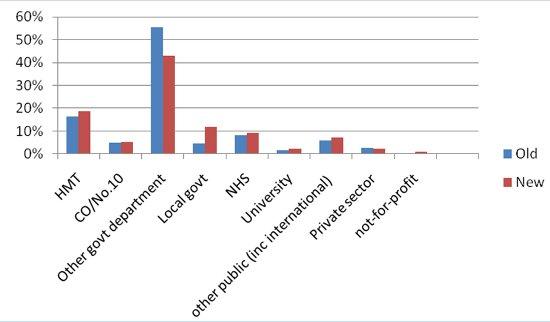A suitable job for a woman
Two big shifts in new permanent secretary appointments.
The new permanent secretary appointments mark two shifts – a significant increase in the number of women, now in control of bigger budgets, and a reinforcement of local government as an alternative route to the top.
We are coming near to the end of the Permanent Secretary musical chairs which started in the summer. So far ten jobs have changed hands. Three appointments are outstanding – at Defra, as Chief Medical Officer and the second permanent secretary at MoD:
Whitehall has collectively lost a lot of experience, with the retirements of long-serving permanent secretaries at the Home Office, Health, Work & Pensions and Defence.
Local government as a training ground
The first thing to say is that in terms of experience it is pretty much as before. Some experience in the Treasury or Cabinet Office helps, but seems to be less essential than it once was. The big change is that two people have made the move from running big agencies / NDPBs to permanent secretary after long careers in local government. That accounts for the one discernible change in the proportion of time spent pre-appointment with a significant shift to local government. The converse is that there is a marked reduction in prior departmental experience. None of the new appointees have any private sector experience.
Thatcher’s daughters?
The other significant change is that four of the ten new appointments went to women. Two were already in the list (though one is a promotion from second permanent secretary to being in charge) and their jobs are two of the outstanding vacancies. The very big difference though is that women are now in charge of a number of very significant spending departments. Before this latest round, there were women Permanent Secretaries at Defra, DECC, DfID and the Welsh Assembly Government – however only at HMRC was a woman the Accounting Officer for a really big budget. They accounted for just under 10% of total spend. That has now changed. There are now women in command at Health and Defence as well – and the appointment of the Home Office’s first woman permanent secretary (in 228 years according to its website) puts a woman in charge of what has traditionally been regarded as a 'Great Office' of state. Together they now control over 34% of government spending, and are in charge in three of the top five spending departments. And the representation of women at the civil service top table vastly exceeds the paltry four female CEOs of the FTSE 100. A cynic might suggest that men got the fun of spending the money during the growth years – and it is only now when the task is overseeing years of retrenchment that women get a chance to take over. Mrs Thatcher might say that you need a woman in charge to carry through the cuts.
- Topic
- Civil service
- Keywords
- Civil servants Diversity and inclusion
- Position
- Permanent secretary
- Publisher
- Institute for Government

